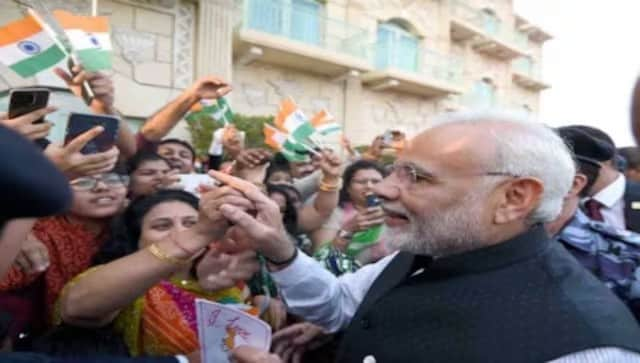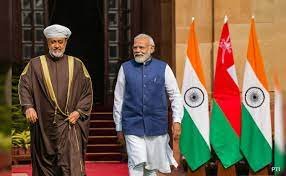Sultan of Oman, Sultan Haitham bin Tarik’s trip to India on 16th December (today) comes in the backdrop of Oman being a key defence partner in the Gulf and the commerce department beginning negotiations for a free trade pact that will ‘significantly boost’ Indian goods. It is also the first visit from a top Gulf leader after the Israel-Hamas conflict.
Sultan Haitham bin Tarik, accompanied by a high-level delegation of senior ministers and officials, was welcomed at the airport by Minister of State (MoS) for External Affairs and Parliamentary Affairs V Muraleedharan.
“This first state visit of His Majesty Sultan Haitham bin Tarik to India marks a significant milestone in the diplomatic relations between India and the Sultanate of Oman,” the Ministry of External Affairs (MEA) said in a statement.
Significance of this Bilateral Meet
The Sultan is visiting India after an invitation from President Droupadi Murmu. External Affairs Minister S Jaishankar will meet the Sultan as well. He will be given a ceremonial welcome by Prime Minister Narendra Modi and President Murmu at the Rashtrapati Bhavan tomorrow.
On day two of his visit, the Sultan will visit the National Gallery of Modern Art and meet Modi at Hyderabad House. Modi will also host a luncheon in the Sultan’s honour.
There are a number of reasons the trip is significant. First, because it continues India and Oman’s long-standing friendship rooted in historical, cultural, and economic ties.
People-to-people contact between India and Oman can be traced back 5,000 years. Diplomatic relations were established in 1955, and the relationship was upgraded to Strategic Partnership in 2008.
Over the years, India’s prime ministers have regularly visited Oman: Rajiv Gandhi (1985), PV Narasimha Rao (1993), Atal Bihari Vajpayee (1998), Dr Manmohan Singh (2008).
In 2018, Prime Minister Shri Narendra Modi’s visit to Oman marked a significant chapter in the bilateral relations between the two countries.

His Majesty is the first huge gulf leader to visit India since the horrific Israel-Hamas conflict started. Oman is not only a dear friend but also a very integral part of India’s defence strategies in the Gulf.
Rumours and Reports point out that the talks held between the head of both the countries will be based on the Gulf conflict and also the Russia-Ukraine war.
Major areas that make India-Oman Relations significant
This visit of His Majesty Sultan Haitham Bin Tarik is of special significance as it marks the Sultanate of Oman’s Sultan’s first visit to India in over 25 years since the late His Majesty Sultan Qaboos’ visit in 1997.

Defence Cooperation
Muscat is India’s closest defence partner in the Gulf region, and defence cooperation has emerged as a key pillar of the strategic partnership between India and Oman.
India’s NSA Ajit Doval delivered a message from the prime minister to the Sultan when he travelled to Oman in June.
Muscat granting India access to the Duqm port in the backdrop of a growing Chinese threat in the Indian Ocean region has proved invaluable.
Oman is the only country in West Asia with which all three services of the Indian Armed Forces conduct regular bilateral exercises and service-level staff talks.
Trade and Investment
Economic ties are robust, with both nations engaging in significant trade and investment activities, especially in sectors like energy, infrastructure, and technology.
Bilateral trade more than doubled from $5.4 billion in 2020-21 to $12.3 billion in 2022-23. There are over 6,000 India-Oman joint ventures in their country, with an estimated investment of over $7.5 billion.
A report released on Tuesday revealed that over 83.5 per cent of Indian goods worth $3.7 billion such as gasoline, iron and steel, electronics, and machinery will get a significant boost in Muscat once both sides reach a comprehensive free trade agreement.
According to the – India-OMAN CEPA: Gateway to Middle Eastern Markets and Beyond – report, prepared by think-tank Global trade Reproach Initiative (GTRI), these goods currently face a 5% import duty in Muscat.
Both the nations are negotiating a comprehensive economic partnership agreement (CEPA), under which the two countries could significantly reduce or eliminate customs duties on the maximum number of goods agreed between them.
With the new trade agreement, these products, including major export items like motor gasoline (exports worth $1.7 billion), iron and steel products (exports worth $235 million), electronics ($135 million), machinery ($125 million), aluminium oxide ($126 million), textiles ($110 million), alumina calcined ($105 million), plastics ($664 million), boneless meat ($50 million), essential oils ($47 million), and motor cars ($28 million), will benefit from duty elimination, it said.
As source told Hindu Business Line, “The Commerce Department has begun negotiations with Oman on a bilateral CEPA and is simultaneously continuing its consultations with line-Ministries and other stakeholders to ensure that it gets the most out of the pact.”
“The India-Oman CEPA, while offering direct economic benefits through import duty reductions, also serves a larger strategic role in India’s foreign policy. While acknowledging the limitations set by Oman’s smaller economic size and population, the agreement’s true value lies in its potential to open doors for India in the Middle East, fostering economic and strategic ties in a region of critical importance,” the report stated.
Indian Diaspora
Muscat is home to a large and vibrant Indian expatriate community, playing a crucial role in Oman’s economic development and cultural diversity.
The Indian diaspora in their country has grown substantially, surpassing 700,000 individuals in the post-pandemic era. This vibrant community contributes to the socio-economic fabric of Muscat across diverse sectors, including professionals such as doctors, engineers, chartered accountants, and healthcare professionals.
Additionally, the diaspora includes a substantial presence of blue-collar workers. There are around 200 families of Indian merchants who have been living in Oman for the last 200-300 years, with some of them having taken Omani citizenship.
Cultural Exchanges
Cultural ties are reinforced through various exchanges, promoting understanding and appreciation of each other’s rich heritage, traditions, and values.
Recently, the National Museum of Oman exhibited a collection of specially curated 20 works of art from the National Gallery of Modern Art collection.
These are some of the iconic paintings by some of the renowned Indian artists like Raja Ravi Varma, Nandalal Bose, Jamini Roy, and Amrita Sher-Gill.
Health
Health cooperation between both the countries stands as a shining example of our collaborative efforts to enhance well-being and healthcare delivery. There are several Indian hospitals in Oman offering advanced medical care.
Ayurveda is very popular in Muscat, and there are more than 35 Ayurvedic hospitals and clinics. Yoga has found great resonance in Oman, particularly among local youth.
G20
Given the strong relationship with them, India extended a special invitation to the Sultanate of Oman to participate in the G-20 Summit and meetings as a Guest country under India’s G20 Presidency.
Muscat actively participated in over 150 working group meetings, and 9 Ministers from Oman participated in various G20 Ministerial meetings.
His Highness Sayyid Asaad, Deputy Prime Minister for International Relations and Cooperation Affairs and the Personal Representative of His Majesty the Sultan, represented Muscat at the G20 Summit, affirming the Sultanate’s commitment to international collaboration.












